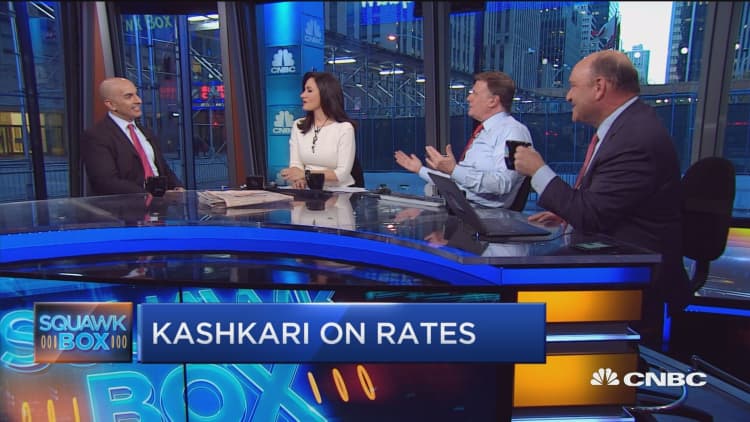
Count Minneapolis Fed President Neel Kashkari as being firmly in the camp of those who believe the central bank can afford patience on interest rates.
In a somewhat unusual post Tuesday on publishing platform Medium.com, Kashkari said the economy has not reached the point in terms of inflation and employment that would necessitate aggressive monetary policy.
As a result, he joined his fellow voting members on the Federal Open Market Committee last week in voting to hold rates steady.
Judging from his analysis, it could be a while before he changes his mind.
"From a risk management perspective, we have stronger tools to deal with high inflation than low inflation," Kashkari wrote. "Looking at all this together led me to vote to keep rates steady."
Fed officials don't often post their thoughts on blogs.
They usually express their thinking first through the policy statements that emerge from FOMC meetings, then from scheduled, individual speeches they present at formal venues.
Kashkari said he chose the Medium platform because the FOMC statements "can be somewhat difficult for the general public to decipher."
The rationale for his dovishness is fairly conventional — there's more room for improvement in the job market than the 4.8 percent unemployment rate suggests, and inflation measures and expectations both remain well-anchored at low levels.
"The bottom line is the job market has improved substantially, and we are approaching maximum employment," he wrote. "But we aren't sure if we have yet reached it. We may not have."
However, his statement comes at an interesting time for Fed policy.
FOMC members in December approved a quarter-point rate hike and indicated that three more are on the way this year. However, the market is pricing in only two moves, according to derivatives marketplace CME.
In December 2015, after approving the first rate hike in more than nine years, committee members had indicated four hikes were on the way in 2016, but ultimately only approved one.
Kashkari remarked on the Fed's trouble with foreseeing the future.
"Our near-term policy predictions have been wrong a lot over the past few years — better to not make such predictions in the first place," he said.
Looking broadly at conditions, Kashkari said Fed policy isn't as lax as it appears with an overnight target rate of 0.5 percent to 0.75 percent.
Taking that target and subtracting a 1.7 percent inflation rate puts the real funds rate at between -1.2 percent and -0.95 percent. But he believes that the natural interest rate, defined as neither supporting nor inhibiting growth, is around zero. So that would mean the current real funds rate is only about 1 percent to the "accommodative" side.
"Monetary policy has been at least this accommodative for several years, including the effects of the Federal Reserve's expanded balance sheet, without triggering a rapid tightening of the labor market or a sudden increase in inflation," Kashkari said.
"This suggests monetary policy has only been moderately accommodative over this period. This level of accommodation seems appropriate today given where we are relative to our dual mandate" of full employment and price stability, he said.
Kashkari said he is "very concerned" about financial stability — he has come down strongly on the biggest Wall Street banks — but believes "monetary policy most certainly cannot address the too-big-to-fail risk."
Overall, he said he believes that the economy will be fine even if the Fed lets inflation run a little hot.
"From a risk management perspective, that suggests, if we are to err, it is better to err on the side of being more accommodative than being more restrictive," he said.


